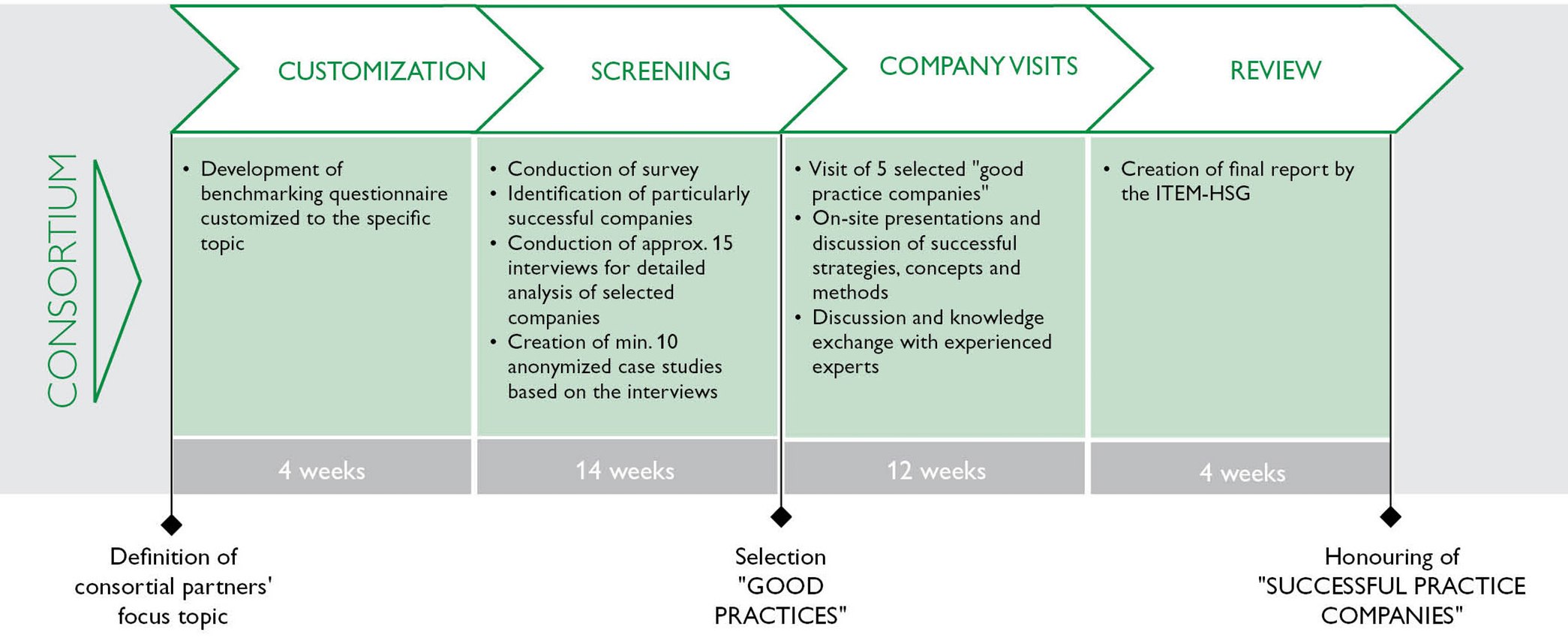Problem Description
Manufacturing companies face multiple risks in an increasingly turbulent and global market environment. Due to the outsourcing campaigns of the last decades and the dispersion of supply chains, particularly the supply side is affected by extreme, external risks. Knowledge on the successful and effective management of supply risks (market price risks, exchange rate risks, and disruption risks) in practice is, however, still scarce.
Objectives of the Benchmarking
Accordingly, the objectives of the benchmarking “Successful Procurement in Volatile Buying Markets“ are:
- to give an overview on state of the art in supply risk management in manufacturing companies,
- to identify successful strategies, concepts and methods in managing supply risks, and
- to identify effective risk strategies and tactics in different business settings.
The Standardized ITEM-HSG Benchmarking Process
The ITEM-HSG conducts benchmarking projects for more than 15 years based on a proofed and standardized benchmarking process, consisting of the following steps:
- Formation of consortium
- Creation of questionnaire
- Screening
- Selection of „good practice companies“
- Visit of „good practice companies“
- Honoring of „successful practice companies“

1. Formation of consortium:
The benchmarking projects of ITEM-HSG are financed by the private sector – generally ba a consortium consiting of 3 to 7 companies. The financiers of “Successful Procurement in Volatile Buying Markets“ are the consortial partners Chocolat Frey AG, REHAU AG, Weidmann Plastics A&I Division, Endress+Hauser Flowtech AG, and Stäubli Sargans AG. All companies have in common that they want to answer one practice driven question, like in this case: „How can manufacturing companies successfully procure in volatile buying markets and thus make a relevant value contribution to their company’s business?“
Addditionally, ITEM-HSG often works with experts that back us up during preparation of the questionnaire as well as during the dissemination phase. For this particular benchmarking we were able to win IMP AG as well as the BMÖ a partner.
2. Creation of questionnaire:
After defining a joint focus topic, the ITEM-HSG develops a customized benchmarking questionnaire which comprises characterizing elements, practices as well as der performance data to evaluate and compare participating companies.
3. Screening:
Based on the questionnaire the ITEM-HSG conducts a quantitative, cross-industry study. Based on the performance data, the ITEM-HSG identifies the 15 most successful companies with regard to supply risk management. These companies will be contacted and via qualitative interviews further challenged. Afterwards, the ITEM-HSG creates anonymized case studies on the interviewed companies, which will serve as basis for the selection for the “good practice companies”.
4. Selection of „good practice companies“
In a next step, the consortium will evaluate the anonymized case studies based on a systematic evaluation process. The five companies that score highest, will be awarded as “good practice companies“ of the benchmarking. The ITEM-HSG, the consortial partners as well as the four other “good practice companies“ will visit each of the “good practice companies“ for one day.
Please note: The ITEM-HSG will clarify upfront with all selected “good practice companies“, if there are any critical competitive relationships with consortial partners or other “good practice companies“. In such cases, these companies are excluded from company visits at competitors.
5. Visit of „good practice companies“
The main objective of the company visits is the mutual exchange between the companies. The companies get to know each other, discuss and challenge the successful concepts and practices with leading experts, and exchange experiences with regard to successful procurement. Besides getting to know different approaches in supply risk management, particularly the networking is in the focus of the benchmarking. Many of our benchmarking partners have established in this way sustainable expert networks and successful partnerships which continued even years after the actual benchmarking projects. In this way, not only the consortial partners but also the good practice companies benefit greatly from the benchmarking.
6. Honoring of „successful practice companies“
During the closing conference at the end of the benchmarking, all company visits will be reviewed and finally evaluated. Based on the assessment the ITEM-HSG will award the true „successful practices“ with the „Successful Practice Award“.
Benefits
All participants of the benchmarking, wether selected as “good practice” or not, will receive a personalized and detailed report of the survey. This report will enable you…
- …to compare your own procurement organization with successful practices.
- …to identify shortcomings and improvement potentials in your procurement organization.
- …to get to know the most successful strategies and practices in dealing with supply risks.
“Good practice“ and “successful practice companies“ will furthermore have the chance to exchange with other successful experts in the area of purchasing and supply chain management and build up long-term networks with successful companies.
Confidentiality
All data will be treated confidentially by ITEM-HSG and not given to third parties, also not the financing consortial partners.
About ITEM-HSG, IMP and BMÖ
The Institute of Technology Management of the University of St.Gallen is a reliable and indepent partner with more than 15 years of experience planning and conducting international benchmarking projects. Different than other benchmarking provides, we consider besides detailed quantitative data analyses also qualitative data analyses. Our target is to generate new scientific insights, transfer them into industry practice and thus create added value for our industry partners.
IMP is an international think-tank that sets itself apart with a unique network and a wealth of strategically relevant expertise. Key areas of IMP are developing know-how, exchanging know-how and applying know-how
BMÖ is the Austrian Association of materials management, purchasing and logistics.
Registration
If you are interested in participating, please fill out the following contact form. We will then send you a personalized link to the benchmarking questionnaire.